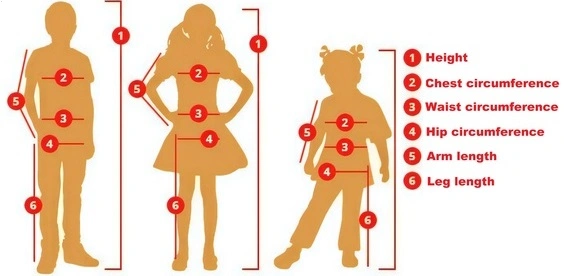Min. order price$300
Min. order price$300

Children's clothing certainly plays an important role in a child's life. Properly selected clothing contributes to the comfort, health and even increased self-esteem of the baby. It is important for parents to know how to determine the size of children's clothing to ensure maximum comfort and safety for their child.
Determining the size of children's clothing can be difficult due to a number of features inherent to the child's body and its development.
Children grow very quickly, especially at a younger age. The difference in size between a baby aged one year and 18 months can be significant.
Children have different physical parameters. For example, one child may be tall and thin, while another may be short and plump.
Children may have individual preferences regarding how they want to wear their clothes. Some people like looser pieces, while others like tighter ones.
Different clothing manufacturers may use different size labeling systems, which can lead to confusion when choosing the right clothing for your baby. However, if you order clothes from one manufacturer, this can be avoided.
Before you start measuring, make sure you have the right tools. You will need a measuring tape, a ruler, and possibly a scale.
To determine the size of children's clothing, it is most important to measure the child's height. Place your child's back straight against the wall and carefully measure the distance from head to heels. Record this value in centimeters.
To accommodate individual body shapes, measure your child's chest, waist and hips using a measuring tape. This is an important step when choosing the right size of your child's clothing.
Bust volume:
Ask your child to stand up straight and relax.
Wrap the measuring tape around the widest part of your baby's chest, passing through the middle of the shoulder blades and in front of the most prominent points of the chest.
Make sure the measuring tape is neither too tight nor too loose to get an accurate measurement.
Waist:
Ask your child to stand up straight and relax.
Wrap the measuring tape around the narrowest part of your child's waist. Usually this place is slightly above the navel.
Again, make sure that the tape measure fits against your body, but not too tight.
Hip size:
Ask your child to stand straight with his feet shoulder-width apart.
Wrap the measuring tape around the widest part of your child's hips.
Make sure that the tape measure fits snugly against your body, but does not squeeze.
Record all values obtained. These measurements will help determine the most suitable clothing size according to the size charts of a particular brand or manufacturer. It's important to remember that sizing may vary by brand, so always try to refer to your specific manufacturer's sizing recommendations. If you need children's clothing from Turkey for children and teenagers, contact the Bebek Clothing online store. They offer a wide selection of stylish Turkish clothing for children aged 0 to 16 years.
Many children's clothing manufacturers provide size charts for children's clothing that indicate the appropriate sizes for a specific age and height. However, remember that these charts may vary between brands, so always check the specific manufacturer's sizing chart.
Some brands also list sizes based on the baby's weight and age in months. This can be helpful, especially for babies.
Children's clothing sizes are usually designated as follows.
For chest:
For waist and hips:
Usually stated in centimeters and depends on the manufacturer, but usually corresponds to age and breast size.
Also, some brands use letter size designations, such as S (Small), M (Medium), L (Large), where each letter has its own size range. For example, S can fit a bust from 50 to 56 cm, M from 62 to 68 cm, and so on.
When choosing a size, pay attention to your child's body shape. For example, if he has broad shoulders or long legs, choose a size that takes those features into account.
Remember that different times of the year require different clothing. A winter jacket should be bulkier to allow for warmer clothing underneath, while summer T-shirts can be more fitted.
Look at the examples and compare them to your child's measurements to see which size is best.
Some brands may have their own peculiarities in fit. Read reviews and recommendations from other parents.
If your child is growing quickly, choose a larger size. This will extend the life of the clothing.
Properly selected clothing ensures the comfort and health of the child, and also saves parents money and time. If you know how to determine children's clothing sizes, your shopping experience will be enjoyable and interesting. Don't be afraid to consult. Remember that every baby is unique and the right size is the one that will make your baby feel comfortable and comfortable.